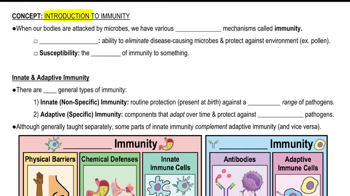Introduction to the Immune System definitions Flashcards
 Back
BackIntroduction to the Immune System definitions
1/15
Terms in this set (15)
- ImmunityThe body's defense mechanism to eliminate disease-causing microbes and protect against environmental agents.
- Innate ImmunityNon-specific protection present at birth, defending against a broad range of pathogens.
- Adaptive ImmunitySpecific protection that adapts over time, targeting specific pathogens.
- PathogensMicrobes or agents that cause disease and are targeted by the immune system.
- AntigensForeign substances that induce an immune response by triggering antibody production.
- AntibodiesY-shaped proteins that bind to specific antigens, facilitating immune responses.
- Physical BarriersInnate immunity components like skin and mucus membranes that block pathogen entry.
- Chemical DefensesSubstances like antimicrobials and acids that protect against pathogens in innate immunity.
- Innate Immune CellsCells involved in non-specific defense mechanisms present from birth.
- Adaptive Immune CellsCells like B cells and T cells that adapt to target specific pathogens.
- B CellsAdaptive immune cells that produce antibodies to target specific antigens.
- T CellsAdaptive immune cells that help in targeting and eliminating pathogens.
- SusceptibilityThe lack of immunity towards a specific agent or pathogen.
- Specific ImmunityAnother term for adaptive immunity, targeting specific pathogens.
- Nonspecific ImmunityAnother term for innate immunity, providing broad protection against pathogens.


